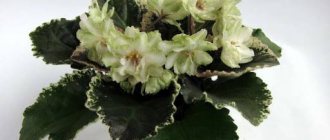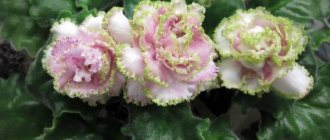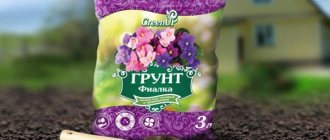Olga Kosenok Knows how to grow violets
The tricolor violet has taken root in my garden thanks to its unpretentiousness. It is completely undemanding and harmless; it is spread with a simple rug. But I collected some features of planting and care that I was able to highlight over 5 years of growing violets.
In the photo - wild Viola Pansy
Description of violet Spring Rose
The progenitor of the variety is the American breeder Paul Sorano. As a result of painstaking work, a violet was obtained with white, densely double flowers resembling roses with a diameter of 4 cm. The edges of the petals have a greenish tint, which weakens during the flowering process and subsequently disappears completely. As you can see in the photo, the Spring Rose violet is distinguished by bouquet flowering, which lasts for 6-8 months if the basic requirements of the culture are met.
The Spring Rose violet bush is compact, standard size, with light green, hairy leaves with a carved edge and a light back. As the plant matures, they acquire a darker shade.
The plant blooms at the age of 10-12 months, forming a large number of greenish buds rising on strong peduncles above the foliage. The lower edge of the leaves begins to hang down as they grow, hugging the pot. Violet forms a shallow root system that develops quickly when the plant's requirements are met. When growing this variety, you must adhere to certain maintenance rules, which guarantees long and abundant flowering.
Display of life phases
The “NK-Fragolino” variety carries out all life processes according to the classical principles of growth for the Saintpaulia genus, differing only in minor nuances according to which variegated varieties live.
Specifics of development in the room collection
Violet belongs to the group of unpretentious varieties, distinguished by :
- Simple requirements for care and the created microclimate;
- Problem-free development and decorative flowering.
He forms a beautiful, exhibition-shaped rosette . The variety is well suited for beginner lovers of exotic beauties.
NOTABLE! Saintpaulia, according to taxonomic rules, included in the cool-loving group of variegated leaves, differs from its fellows in a more loyal attitude to temperature indicators. It tolerates warm microclimates well (+ 22°C and above), under these conditions the color of the corollas becomes more intense and the temperature does not interfere with their establishment. According to reviews from experienced specialists, pink varieties generally like warm conditions.
From flowering to flowering, the variety is able to increase the density of the color of the buds - when the very first flowers bloom, they may not be at all impressive in color and may not show the sophistication promised by the author.
Growth to adult specimen
A violet, according to the laws of botany, can be called an adult plant at the moment of the first bud formation, even if a single flower has formed.
The time from rooting to flowering is automatically considered the maturation phase, and NK-Fragolino spends the standard number of months to complete it.
The only difference is in the method of obtaining the baby :
- With leaf - maturing in eight months;
- When the stepson takes root, the period is significantly reduced.
Peculiarity of reproduction
Violet growers for propagation of "NK-Fragolino" use standard vegetative procedures :
- Rooting children from cuttings with leaves;
- Planting the shoot grown by the plant.
CAREFULLY! “Strawberry” violet cannot be propagated by seeds - there is an almost one hundred percent risk of losing the variety!
When violets are rejuvenated, all of their varietal qualities are perfectly preserved .
Effect of temperature on flowers
At low temperatures, favorable for the growth of all variegated violets, the “strawberry” variety blooms with inexpressive shades of buds .
This varietal violet is distinguished by its love of warm conditions for the flowering phase.
With optimal comfortable parameters, violet corollas will have rich shades with intense darkening along the edges of the petals.
Extreme heat negatively affects even this heat-loving variety:
- Flowering may not occur at all;
- Or its timing will shift to a more appropriate time.
The structure of peduncle branches
Violet from the first buds has strong, optimally long peduncles . But the formation of single branches during the first flowering does not create sufficient support for the peduncles, which can bend due to the weight of the flowers.
Next, a flowering cap is formed, and the flower stalks easily hold the corollas in a straight position.
Flowering form model
Since the volume of flowering increases as the violet grows , the first blooms are somewhat liquid, with peduncles curving down.
Experts advise cutting off the first buds completely so as not to interfere with the harmonious development of the bush. After this procedure, during subsequent flowering, the violet produces lush corolla caps.
Flower lifespan
The variety is able to maintain the decorative quality of the flowering cap for a fairly long period of time , which becomes possible thanks to the long life span of individual corollas (a little more than a month).
But flowers have an unpleasant feature - as they grow older :
- They lose color density;
- They become light and without a dark ribbon along the edge.
The presented violet blooms for more than a month.
Watering and humidity
Spring Rose violet does not tolerate waterlogging of the soil, which leads to rotting of the roots. Therefore, watering must be carried out when the top layer of soil dries, avoiding moisture getting on the foliage. Therefore, it is best to use a watering can with a long narrow spout.
The optimal humidity level is 50-60%. However, you cannot spray the leaves additionally, as this leads to their deformation and rotting of the petioles. Therefore, in order to increase the humidity to the required level, it is recommended to place additional containers of water next to the pot, which will increase the area of evaporation.
Transplanting a plant
In the process of growing Spring Rose violets, it will be necessary to annually transfer the plant into a new pot, which guarantees the full development of the rosette and long-term flowering.
The main signs indicating the need for a transplant:
- slow growth;
- root shoots appeared from the drainage holes;
- a thickened bare trunk has formed at the base;
- long absence of flowering;
- the bush looks weakened.
For the plant, you need to choose a pot 1-1.5 cm wider in diameter than the previous one. It is recommended to replant using the transshipment method, without exposing the root, but only filling the resulting voids with earth. But if the root system is rotten, it is necessary to cut it back to healthy tissue and remove as much old soil as possible.
For violets, you need to prepare special soil, which can be purchased at any specialty store. But it can also be prepared at home.
To do this you will need to mix the following components:
- peat - 30%;
- coconut substrate - 20%;
- turf soil - 30%;
- river sand - 10%;
- perlite - 10%.
This composition fully meets the needs of the violet and will allow the bush to fully develop and grow.
Subsequently, the transplantation procedure is carried out in several stages.
- Place a layer of drainage on the bottom of the pot 1 cm high.
- Sprinkle nutrient soil on top.
- Take out the plant and shake off the old soil a little.
- Remove the bottom row of leaves.
- Place the violet in the center and water a little.
- Fill the voids with prepared soil and compact lightly.
After replanting, the lower leaves should touch the edge of the pot. Place the violet in a shaded place for 2-3 days to adapt, and then move it to a window and water it a little. If the soil settles slightly, it must be added.
The procedure can be carried out in early spring, as well as during the summer and early autumn. It is not recommended to do this in winter since the Spring Rose violet is in the dormant stage, so all growth processes in the plant slow down.
Violet RM-Sister Alyonushka
A marvelous variety of white varieties has represented the standards since 2015.
Angelic violet Sister Alyonushka.
Image of decorative features
Violets of optimal dimensions from the first day carefully and independently lay out leaf plates within the boundaries of the even contours of the rosettes , adhering to the principle of tiled laying accepted in architecture.
As a result, mature bushes of a compact configuration appear with a clearly calculated symmetry of the leaf pattern.
The oval texture of violet leaves with a noticeably pointed tip differs:
- Quilted surface with a fleecy texture;
- Clear graphics of pressed veins;
- Coarsely cut teeth along a wavy edge;
- And the bright colors of summer foliage.
The violet is especially valued due to the regal texture of the white flowers with a pinkish glow emanating from the center: the corollas are huge in size and the number of their petals corresponds to the dense version of the terry type and, due to the strong fringe of the petals, form lush, airy pompoms.
Sports
Violet is characterized by a lack of sports activity.
Sports are not found in this variety.
Specifics of room keeping
Violet blooms in large volumes and for a long time - unlike many varieties with white flowers, Saintpaulia corollas can remain fresh for quite a long time. The size of the flowers and their number surprise you from the first wave of budding.
IMPORTANT! Lush caps stand upright due to the efforts of strong but short peduncles.
The variety produces large white flowers.
Reviews
Vera Sergeevna. “I added the violet “Sister Alyonushka” to the collection - I’m not particularly fond of white varieties, but this violet “caught me” with its huge balls of flowers and pink radiance from the center. Now I recommend this variety to all my friends.”
Possible problems
With minimal care, the Spring Rose violet is able to fully bloom and develop, but sometimes there are situations when, without the help of a grower, it can die. Therefore, it is important to monitor the general condition of the plant and promptly respond to negative changes, as they are a sign of exposure to pests or diseases.
Typical problems with violets:
| Name | Cause | Characteristic signs | Elimination methods |
| Root rot | Regular overflow, use of cold water, reduced temperature | The plant looks dejected, the leaves lose turgor and become soft, but do not change color | The plant can be saved only at the first signs of disease. It should be replanted in new soil and watered with Maxim or Previkur. |
| Powdery mildew | Excess nitrogen in the soil, keeping it close to the affected plant, transplanting into contaminated soil | White coating on leaves and petioles | Spray the plant with any of these preparations “Topaz”, “Skor”, “Fitosporin” |
| Rust | Lack of light, non-compliance with temperature conditions | Brown spots on leaves that gradually increase in size | Spray and water the plant with “Skor” or “Fitosporin” |
| Spider mite | Dry air, low humidity, high temperature | Slow growth, dejected appearance, leaves in the center do not develop, the edge of the leaf blade turns down | Treat twice with Actellik or Fitoverm with a break of 7 days |
| Thrips | Close keeping with a bouquet of garden flowers or with an already affected plant | Pollen spills out of the flowers, dirty spots appear on the flowers and white spots on the leaves. | Spray the violet with “Actellik” or “Actocyte”, repeat the procedure every 10 days until the pest is completely destroyed |
With proper care, this variety of violet can delight with its abundant flowering over a long period of time. But if the maintenance requirements are ignored, the plant will not be able to fully develop.
Violet RM-Cynthia
Delicate Saintpaulia Cynthia.
The touching white standard with pinkish shades and transitions began to be found in collections since 2016.
Demonstration of specific traits
Violet is a very disciplined plant:
- She herself tightly arranges mosaic patterns of leaves in tiers;
- It itself ultimately forms a magnificent, almost flat rosette, distinguished by: Compact structure configuration;
- And neat symmetry of the edge.
Bushes of this variety, as in the implementation of architectural projects, from the outside look like a clear graphic picture due to the alternation of all elements - leaves - in a mosaic technique.
The leaves are broadly oval in shape with a noticeably pointed tip and have:
- Large sizes;
- Active waviness of the configuration of the side edges;
- Clearly extruded venation graphics;
- Emphasized by a salad tone color;
- Quilted surface;
- Large - wavy, but neatly cut edge teeth;
- And the general tonality in the colors of lush summer foliage.
ATTENTION! The violet bush blooms with huge corollas of simple filling, having a “star” type texture and painted with a white color, which is noticeable only at the stage of bud opening. On the main background of the petals, shades of pink prints are very densely intertwined, onto which the lemon tone of the core is sprayed in the center of the corolla. This forms a spot of bright tonality in the center. A thin pink edging ribbon is visible along the edge of the petals. Each of the “star” petals visually forms a ray narrowed in the middle, ending in an expansion with a fringe.
The variety has large, wavy flowers.
Sports
Violet is characterized by the stability of varietal categories; it does not form sports.
Unique development in the room
Saintpaulia represents a group of varietal varieties that:
- React positively to classically simple methods of care;
- And they are very unpretentious in terms of their content.
Violet is distinguished by a lot of positive qualities:
- It itself builds a compact and dense structure of the bush;
- It has a huge number of buds on each peduncle;
- Gives leaf babies a color similar to a chimera;
- Supports long flower life.
Saintpaulia blooms very luxuriantly.
Reviews
Genrikh Ilyich. “ The variety “Cynthia” amazes with its excellent quality. Everything about it is almost perfect. But the most mysterious thing: the color of the flowers is close to the texture of chimeras, and the violet easily transmits this characteristic through leaf children, which is not possible with chimeras.”











